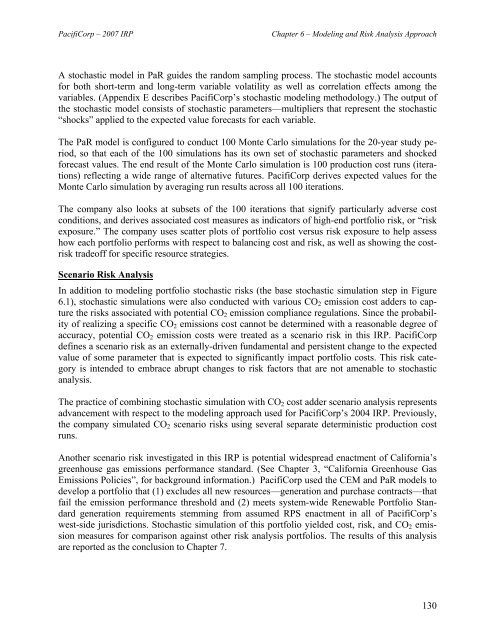PacifiCorp 2007 Integrated Resource Plan (May 30, 2007)
PacifiCorp 2007 Integrated Resource Plan (May 30, 2007)
PacifiCorp 2007 Integrated Resource Plan (May 30, 2007)
You also want an ePaper? Increase the reach of your titles
YUMPU automatically turns print PDFs into web optimized ePapers that Google loves.
<strong>PacifiCorp</strong> – <strong>2007</strong> IRPChapter 6 – Modeling and Risk Analysis ApproachA stochastic model in PaR guides the random sampling process. The stochastic model accountsfor both short-term and long-term variable volatility as well as correlation effects among thevariables. (Appendix E describes <strong>PacifiCorp</strong>’s stochastic modeling methodology.) The output ofthe stochastic model consists of stochastic parameters—multipliers that represent the stochastic“shocks” applied to the expected value forecasts for each variable.The PaR model is configured to conduct 100 Monte Carlo simulations for the 20-year study period,so that each of the 100 simulations has its own set of stochastic parameters and shockedforecast values. The end result of the Monte Carlo simulation is 100 production cost runs (iterations)reflecting a wide range of alternative futures. <strong>PacifiCorp</strong> derives expected values for theMonte Carlo simulation by averaging run results across all 100 iterations.The company also looks at subsets of the 100 iterations that signify particularly adverse costconditions, and derives associated cost measures as indicators of high-end portfolio risk, or “riskexposure.” The company uses scatter plots of portfolio cost versus risk exposure to help assesshow each portfolio performs with respect to balancing cost and risk, as well as showing the costrisktradeoff for specific resource strategies.Scenario Risk AnalysisIn addition to modeling portfolio stochastic risks (the base stochastic simulation step in Figure6.1), stochastic simulations were also conducted with various CO 2 emission cost adders to capturethe risks associated with potential CO 2 emission compliance regulations. Since the probabilityof realizing a specific CO 2 emissions cost cannot be determined with a reasonable degree ofaccuracy, potential CO 2 emission costs were treated as a scenario risk in this IRP. <strong>PacifiCorp</strong>defines a scenario risk as an externally-driven fundamental and persistent change to the expectedvalue of some parameter that is expected to significantly impact portfolio costs. This risk categoryis intended to embrace abrupt changes to risk factors that are not amenable to stochasticanalysis.The practice of combining stochastic simulation with CO 2 cost adder scenario analysis representsadvancement with respect to the modeling approach used for <strong>PacifiCorp</strong>’s 2004 IRP. Previously,the company simulated CO 2 scenario risks using several separate deterministic production costruns.Another scenario risk investigated in this IRP is potential widespread enactment of California’sgreenhouse gas emissions performance standard. (See Chapter 3, “California Greenhouse GasEmissions Policies”, for background information.) <strong>PacifiCorp</strong> used the CEM and PaR models todevelop a portfolio that (1) excludes all new resources—generation and purchase contracts—thatfail the emission performance threshold and (2) meets system-wide Renewable Portfolio Standardgeneration requirements stemming from assumed RPS enactment in all of <strong>PacifiCorp</strong>’swest-side jurisdictions. Stochastic simulation of this portfolio yielded cost, risk, and CO 2 emissionmeasures for comparison against other risk analysis portfolios. The results of this analysisare reported as the conclusion to Chapter 7.1<strong>30</strong>
















